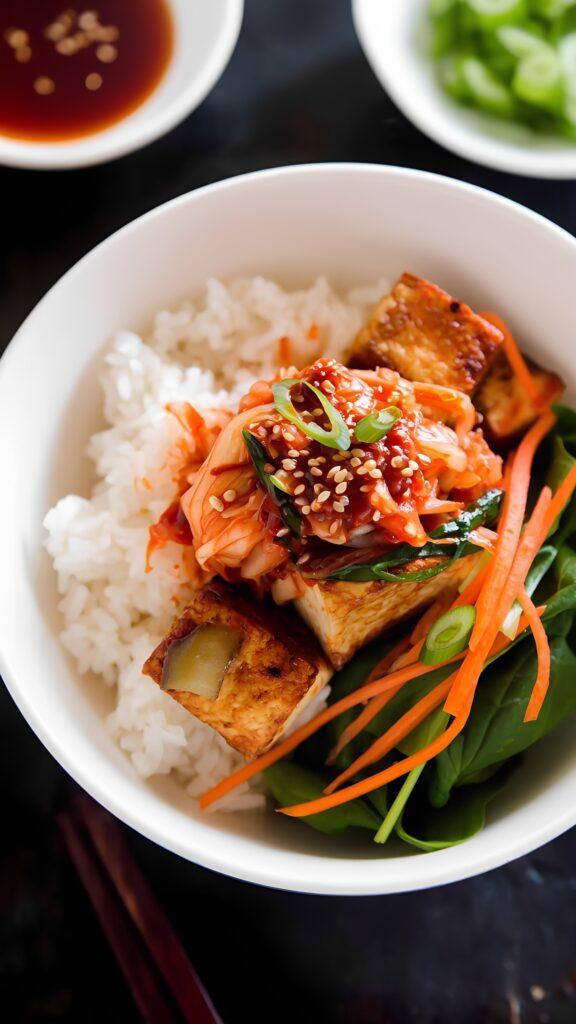
Fermented Kimchi Rice Bowl is a delightful blend of spicy, tangy, and umami flavors, packed with vibrant vegetables and hearty grains. This dish is a celebration of Korean culinary traditions wrapped in a bowl of comfort food that promises to excite your taste buds.
Fermented foods have been a cornerstone of Korean cuisine for centuries, with kimchi reigning as the quintessential staple. Historically, kimchi was vital for surviving harsh winters, a time when fresh vegetables were scarce. The fermentation process not only preserved the vegetables but also enhanced their flavors, creating the signature spicy, sour kick that kimchi is known for. Introduced to rice bowls, it transforms a humble grain into a bold, flavor-packed dish that reflects the ingenuity and resourcefulness of Korean culinary practices.
This recipe marries the fiery notes of kimchi with the earthy undertones of sesame oil and the nutty richness of perfectly cooked rice. The magic lies in the balance of textures and flavors: the crispness of fermented cabbage, the softness of rice, and the gentle crunch of scallions. Each ingredient plays its part, like a symphony, where every note enhances the overall melody. The finishing touch? A runny fried egg perched atop, adding a creamy, luscious layer that binds the dish together beautifully.
The technique of cooking rice to just the right consistency is crucial—neither too sticky nor too dry, it should hold its own against the robust kimchi. Sautéing the kimchi releases its deep, complex flavors, mingling with the fragrant sesame oil and garlic. It’s a dance of heat and time, ensuring the flavors meld perfectly without losing their individual character. This dish, though simple in its ingredients, requires patience and attention to detail, embodying the art of Korean cooking that celebrates both tradition and taste.
This vibrant rice bowl combines fermented kimchi with fresh vegetables and savory proteins, creating a balanced, nutritious, and satisfying meal that's both traditional and innovative.
For a twist on the classic fermented kimchi rice bowl, consider these notes: 1. **Rice Selection**: Opt for short-grain rice for its stickier texture, which complements the spicy tang of kimchi perfectly. If you prefer a nuttier flavor, use brown rice or quinoa. 2. **Kimchi Variations**: While napa cabbage kimchi is traditional, radish kimchi can add a crunchy texture. Make sure your kimchi is well-fermented for an intense flavor punch. 3. **Protein Options**: Top your bowl with a poached egg for creaminess, or add sliced grilled tofu for a vegan alternative. Leftover rotisserie chicken can also bring a savory depth. 4. **Toasting Sesame Seeds**: Toast sesame seeds until golden to enhance their nutty flavor. This step elevates the dish with a subtle crunch. 5. **Balancing Flavors**: A drizzle of sesame oil and a splash of soy sauce can balance the sourness of the kimchi and the earthiness of the rice. 6. **Fresh Additions**: Consider adding thinly sliced cucumbers or scallions for freshness and a pop of color. 7. **Garnishing**: Finish with a sprinkle of chopped nori or a dash of gochugaru (Korean chili flakes) for an extra layer of spice. 8. **Storage**: Store leftovers in an airtight container in the refrigerator for up to two days. Reheat gently to maintain texture integrity. 9. **Customizations**: Experiment with adding pickled vegetables or a spoonful of gochujang (Korean chili paste) to tailor the heat to your liking. These notes aim to enhance your kimchi rice bowl experience, offering both traditional and innovative elements to explore.
Fermented kimchi rice bowls are a symphony of vibrant flavors and textures—a culinary canvas where spicy, tangy, and umami notes dance in harmony. Each bite offers a taste of tradition with a modern twist, reminiscent of bustling street markets and cozy family kitchens. The fermentation process transforms humble ingredients into a masterpiece, creating a depth of flavor that's both comforting and invigorating.
This dish always reminds me of my first visit to a quaint Korean village, where I was warmly welcomed and introduced to the art of fermentation. It was a moment of shared laughter and learning, of tasting the history and culture embedded in each spoonful. Making this recipe at home transports me back to those cherished memories, bringing a slice of that vibrant world into my kitchen.
Enhance your rice bowl by topping it with a perfectly fried egg, its yolk oozing over the grains like liquid sunshine. Pair it with a side of fresh cucumber salad for a refreshing contrast. For an extra kick, sprinkle toasted sesame seeds or nori strips for added texture and flavor.
Leftovers can be stored in an airtight container, and the flavors will only deepen over a day or two. Feel free to experiment by adding protein like grilled chicken or tofu for a heartier meal. You can even swap the white rice for brown or cauliflower rice to suit your dietary preferences.
I invite you to embark on this culinary adventure by trying the recipe and making it your own. What unique twists will you bring to the table? Share your stories, discoveries, and questions—after all, cooking is a journey best shared with fellow food enthusiasts. Let's continue to explore and celebrate the magic of flavors together.